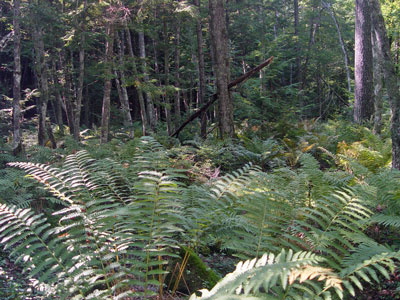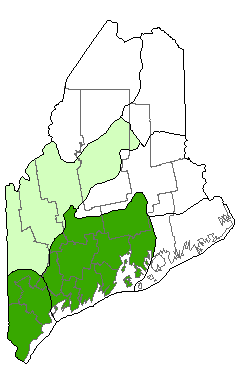DACF Home → Bureaus & Programs → Maine Natural Areas Program → Communities, Plants, and Animals → Natural Community Fact Sheets → Pocket Swamp
Printer Friendly Fact Sheet - 750 KB pdf (Get a free copy of Adobe Acrobat Reader)
Pocket Swamp
Scientific Name: Hemlock - Hardwood Pocket Swamp; State Rank: S2

- Community Description
- Soil and Site Characteristics
- Diagnostics
- Similar Types
- Conservation, Wildlife and Management Considerations
- Distribution
- Characteristic Plants
- Associated Rare Plants
- Associated Rare Animals
- Examples on Conservation Lands You Can Visit
Community Description: These forested wetlands may be deciduous or mixed and typically occur as small depressions within an upland landscape. Red maple almost always dominates the canopy and occurs with hemlock and/or black gum. Black gum is an uncommon tree in Maine and is a good indicator of this community. Shrubs may be locally dense and include highbush blueberry and winterberry. The herb layer is variable in extent, and often features large clumps of ferns. In southern Maine, several plants that are rare in Maine are associated with these wetlands. Back to top.
Soil and Site Characteristics: Sites occur in small isolated basins, sometimes perched on the sides of gentle hills, with a seasonal high water table. The soil may dry out during the summer, or pools of water may remain among the forested hummocks. Often these basins have no surface outlet, or they may drain only at high water. Soils are acidic, usually with a thin peat layer over mineral soil, occasionally with deeper peat. These wetlands typically occur as small patches (typically <3 acres) in otherwise well drained, forested uplands. Back to top.
Diagnostics: Hemlock and/or red maple are dominant; black gum is often present, and high bush blueberry, winterberry, and/or maleberry occur in the understory. Wetland soils occur in isolated drainages, not along a stream or large drainage flat. Back to top.
Similar Types: Red Maple Swamps occur along alluvial soils of broad streams or lake basins and are more strongly dominated by red maple. Hardwood Seepage Forests have less red maple, more ash and yellow birch. Back to top.
Conservation, Wildlife and Management Considerations: Timber harvesting lowers the natural community values of these small and often isolated wetlands. Because these tend to occur as small forest patches, their conservation depends in part on maintaining some surrounding forest cover as a buffer. They should be buffered from direct impacts, such as physical disturbance to the soil, and indirect impacts, such as water quality degradation. Only a few examples are known on public lands or private conservation lands.
Many occurrences of this community type function as vernal pools, which are important breeding habitats for a variety of amphibians including wood frogs, spotted salamanders, and blue-spotted salamanders. Rare turtles such as Blanding’s and spotted turtles may feed on amphibian egg masses present in such pools. If peaty hummocks are common, four-toed salamanders may breed in these wetlands. Occurrences of this community type in which spicebush is present may host the spicebush swallowtail butterfly, whose larvae feed only on spicebush and sassafras. Back to top.
Distribution: Limited to the southern, central, and midcoast regions of the state, primarily in the Eastern Broadleaf Forest Province, and extending southward and southwestward from Maine. Landscape Pattern: Small Patch; known sites are 2 - 30 acres. Back to top.


Characteristic Plants: These plants are frequently found in this community type. Those with an asterisk are often diagnostic of this community.
- Canopy
- Black gum
- Eastern hemlock
- Red maple
- Yellow birch
- Sapling/shrub
- Highbush blueberry
- Maleberry
- Mountain holly
- Wild-raisin
- Winterberry
- Yellow birch
- Dwarf Shrub
- Lowbush blueberry
- Herb
- Bluejoint
- Cinnamon fern*
- Goldthread
- Long sedge
- Marsh fern
- Northern water-horehound
- Royal fern*
- Three-seeded sedge*
- Blanding's turtle
- Spicebush swallowtail
- Spotted turtle
Examples on Conservation Lands You Can Visit
| Example | County |
|---|---|
| Brownfield Bog Wildlife Management Area | Oxford Co. |
| Long - Short Pond, Ferry Beach State Park | York Co. |
| Mt Agamenticus | York Co. |